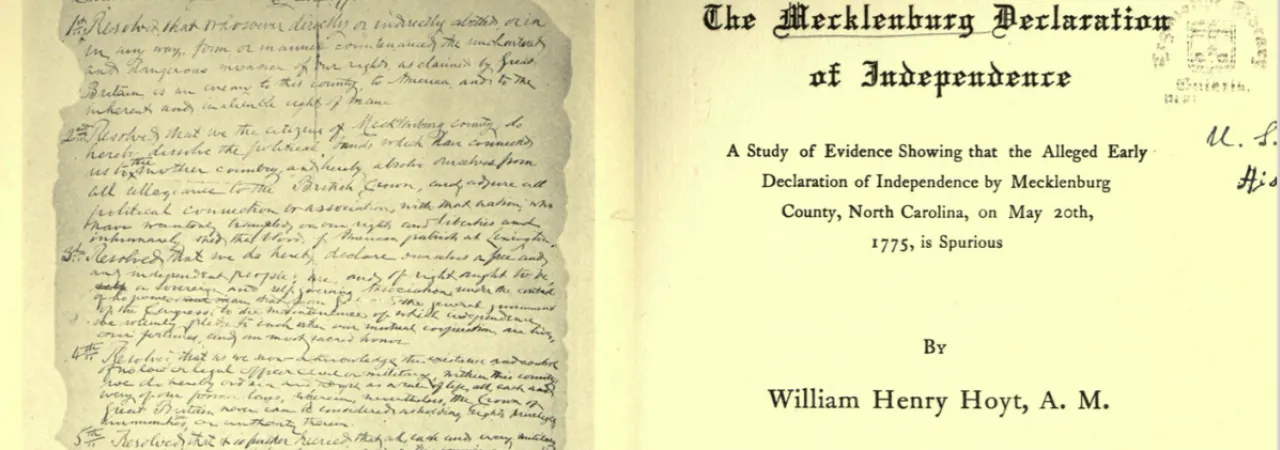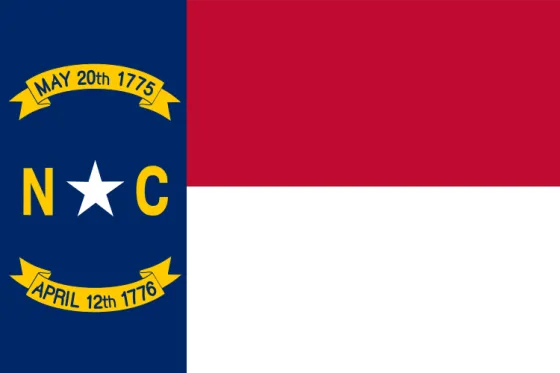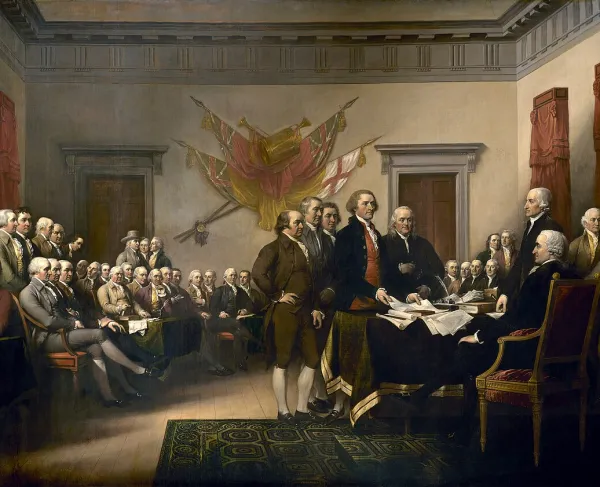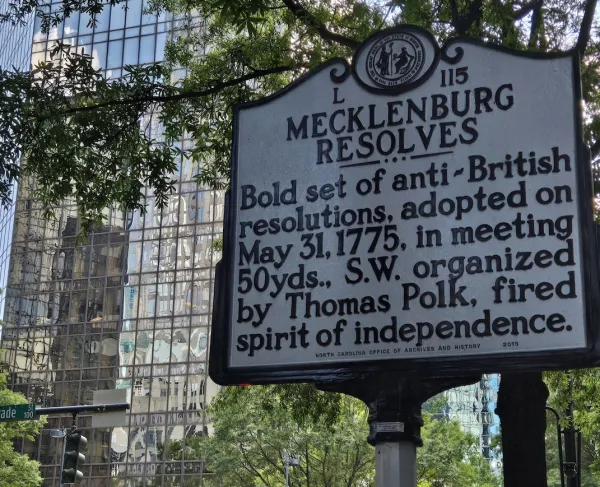
The Mecklenburg Declaration of Independence is an alleged document that, if proven to exist, would predate the 1776 Declaration of Independence in its call for independence from Great Britain. On April 19, 1819, 44 years after the adoption of the Declaration of Independence, Joseph Mcknitt Alexander published an article in both the Raleigh Register and the North Carolina Gazette. His article claimed that on May 20, 1775, in Charlotte, North Carolina, NC delegates, after hearing of the Battles of Lexington and Concord, wrote the Mecklenburg Declaration of Independence, declaring their independence from Great Britain. In the article, Joseph Alexander claimed that his father, John McKnitt Alexander, was a clerk at the meeting of the delegates and had shared papers with his son that described what was written in this declaration.
Joseph Alexander explained that within the supposed declaration, the delegates in Mecklenburg County dissolved their relationship with Great Britain and declared the mother country as an enemy to their own county, to America, and to the inalienable rights of man. The most contentious point of the article was that the Mecklenburg Declaration used suspiciously similar phrasing to Thomas Jefferson’s 1776 Declaration of Independence. Therefore, if the claims were true that the Mecklenburg Declaration existed, it could indicate two things: first, that North Carolina was the first colony to declare their independence; and second, that parts of the American Declaration of Independence were likely influenced, if not directly copied from this Mecklenburg Declaration.
North Carolina was already well-known for its Halifax Resolves passed on April 12, 1776. These Halifax resolves made North Carolina the first colony to permit their delegates to vote for and push for independence from Great Britain; however, Halifax Resolves were not a direct call for independence. The Mecklenburg Declaration of Independence was different because it was said to have directly declared their colony’s independence.
In the 1819 article, Joseph Alexander wrote that North Carolinian, Captain James Jack, rode to Philadelphia with the Mecklenburg Declaration to present it to the Continental Congress. However, according to Alexander, Captain Jack was turned away by the North Carolina delegation at the congress who believed that Congress was not ready to call for independence at that time. The validity of the Mecklenburg Declaration of Independence is called into question because although Joseph Alexander said that his father left him some papers indicative of the existence of the supposed declaration, he claimed that the document itself burned in a fire; therefore, all evidence of its existence is based only on eyewitness accounts.
The information contained in Joseph Alexander’s article was widespread and reached prominent leaders in the country, including Thomas Jefferson and John Adams who had their own opinions as to the authenticity of the claim. Adams initially supported the authenticity of the Mecklenburg claim in private, perhaps because he harbored resentment towards Jefferson for the credit given to him for the 1776 Declaration. To Jefferson, the news of this “original” declaration of independence was a shock. Jefferson, maintaining his own integrity and standing in defense of the originality of his own 1776 Declaration of Independence rejected the claim of the existence of this 1775 Mecklenburg Declaration. He wrote a letter to John Adams questioning how and why a supposed document of this importance was kept secret for 44 years. Additionally, Jefferson was suspicious of the fact that the document had burned in a fire, and that, at that point, most of the “eyewitnesses” of the creation of the Mecklenburg Declaration were dead. After John Adams read Jefferson’s response to the article claims, he supported Jefferson’s opinions and forwarded the skeptical letters to a newspaper, keeping their identities anonymous.
Many North Carolinians were angered by the skeptical attitude towards the claim. North Carolina Senator, Nathaniel Macon, began interviewing alleged eyewitnesses of the signing of the Declaration to argue for the existence of the 1775 document. From these interviews, Macon established that most of the men who were eyewitnesses corroborated the claim that there was a document declaring independence, read in Charlotte, NC; however, few of the men could agree on the date that the document was read. Captain John Jack, who was elderly at the time, maintained that he rode to the Philadelphia Continental Congress in 1775 to deliver the Mecklenburg Declaration of Independence. For many supporters of the Mecklenburg Declaration, these interviews, combined with Captain Jack’s testimony were enough to verify not only the existence of the Mecklenburg Declaration, but also the fact that it predated the United States 1776 Declaration by a year.
Although these interviews garnered support for the Mecklenburg document, the claims were disputed for years to come. Supporters of the existence of the unverified declaration compiled a list of men that they believed had signed the May 1775 document. On May 20, 1825, North Carolina began celebrating the anniversary of the Mecklenburg Declaration. In 1829, 10 years after the publication of Joseph Alexander’s article, Thomas Jefferson’s skeptical letter to John Adams was published posthumously. Jefferson’s blatant rejection of the Mecklenburg claims caused an uproar in the authenticity debate. The supporters grew more adamant, and the opponents were further solidified in their rejection of the claims. In 1831, the North Carolina government issued a pamphlet that reiterated Alexander’s claims in the 1819 article in addition to the new testimonies of the eyewitnesses, including that of Captain John Jack.
Throughout the 1830s, published books continued the debate on the validity of the 1775 document. Some books claimed that the Mecklenburg Declaration, if it existed, was written later than claimed and copied Jefferson’s 1776 Declaration of Independence, while others claimed that Jefferson had directly plagiarized parts of the Mecklenburg document. Mecklenburg supporter Francis L. Hawks called attention to an August 1775 proclamation by Royal Governor Josiah Martin in which Martin wrote that he had seen a newspaper article that published resolves by a Mecklenburg committee declaring the dissolution of the laws and government and setting up a new system of rule. Although this may have been a breakthrough for the case for the supporters of the 1775 declaration, the newspaper issue with the resolves that Martin referenced could not be found. In the early 1900s, as the debate still lingered, it was confirmed that the resolves to which Governor Martin referred were not those of a Mecklenburg Declaration of Independence but were instead a set of resolutions called the Mecklenburg Resolves. The Mecklenburg Resolves were not a declaration of independence. Instead, they were a radical list of resolves created on May 31, 1775, that rejected laws set forth by the British King and Parliament.
This was a breakthrough for the argument against the Mecklenburg Declaration of Independence because most people inferred that all along, Joseph Alexander and the eyewitnesses had mistakenly been referring to these Resolves. It seemed unlikely to many that delegates in Mecklenburg had declared independence from Great Britain on May 20, 1775, before coming back together 11 days later to pass resolutions about vacating the laws of the King. For opponents of the Mecklenburg Declaration, they believed that the Mecklenburg Declaration of Independence was a misdated reiteration of the Mecklenburg Resolves with the language of Jefferson’s 1776 Declaration intermixed. Supporters of the Declaration maintained the existence of both the Resolves and the Declaration.
While the debate over the Mecklenburg Declaration of Independence still exists on a small scale, most modern historians agree that the 1775 Declaration is fake; although, others say it is impossible to either confirm or deny the existence as it is impossible to discount it as fake. When speaking of the validity of the Declaration, historian Dan L. Morrill said, “Ultimately, it is a matter of faith, not proof. You believe it or you don’t believe it.” North Carolina chooses to believe it, as the state symbol and flag both continue to bear the date May 20, 1775 – the creation of their state’s alleged contribution to the movement toward American independence.






